23 Shade Annuals That Will Thrive Without Sun
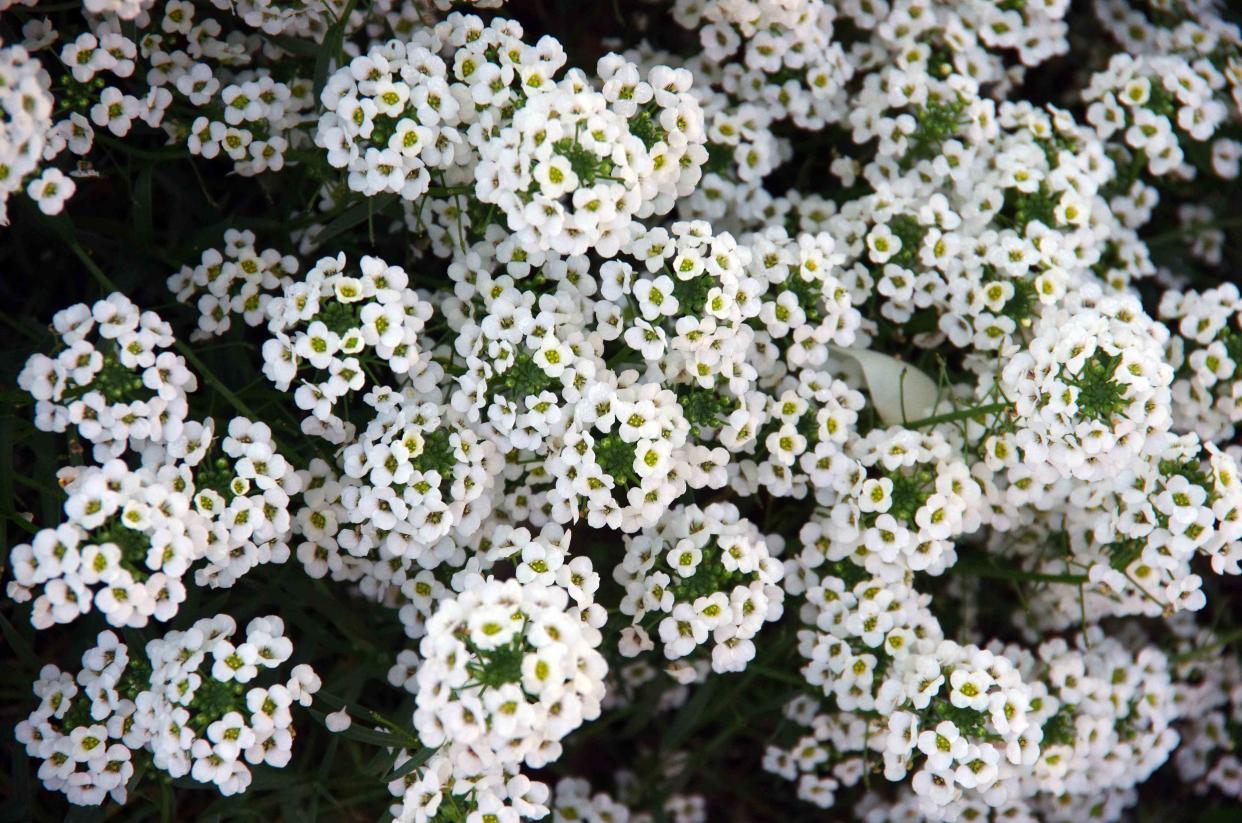
Getty Images/Simon McGill
You'll find beautiful annuals for shade that will give you vibrant blooms and foliage even if your landscape lacks sun exposure. Some flowers love the shade and put on their most colorful shows when they're hidden from direct sunlight or given just a few hours of sunlight a day.
From groundcover flowers with dainty blooms to neon leaves that add interest to a wooded garden, read on to learn about these 23 floral and foliage annuals that thrive in the shade where they're protected from the scorching heat of the afternoon sun.
Warning
Some of the plants listed here may be toxic to humans, animals, or both, as indicated below.
Annuals for Shade
Begonia
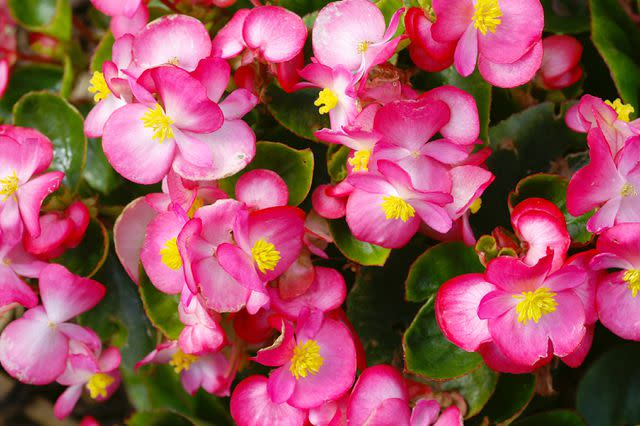
schnuddel / Getty Images
Shade-loving begonia have waxy blooms and rounded rich green leaves that provide vibrant color all summer long. In tropical climates, they’re hardy year-round, but for most zones, they’re grown as annuals that love shady, warm weather and then die off at the first frost. Begonias can be toxic to animals.
Name: Begonia (Begonia)
USDA Hardiness Zones: 9-10, some varieties 6-9
Flower Color: Pink, red, white, yellow, orange
Light: Partial sun to shade
Bloom Time: Spring until first frost
Sweet Alyssum
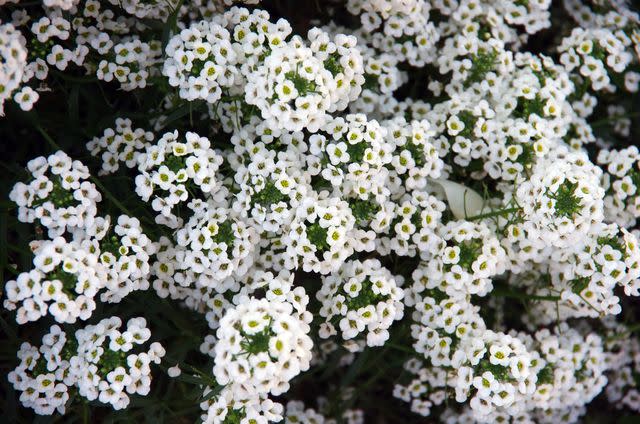
Simon McGill / Getty Images
Sweet alyssum (Lobularia maritima) needs a few hours of sun a day but does best when it’s protected from the heat of afternoon sun in a partial shade garden. These darling white blooms form a carpet of color in the cool of early spring, then the flowers pop up again when the temperatures drop in fall. Note that sweet alyssum is considered invasive in various parts of the country but mostly in parts of California.
Name: Sweet alyssum (Lobularia maritime)
USDA Hardiness Zones: 5-9
Flower Color: White, pink, purple
Light: Partial shade
Bloom Time: Spring, fall
Lobelia
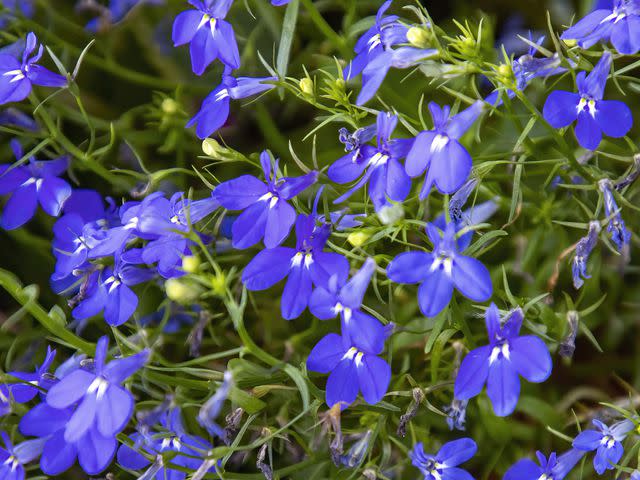
Ali Majdfar / Getty Images
Spreading gently throughout the summer, lobelia (Lobelia erinus) leaves a trail of small but abundant flowers in blue, purple, pink, white, and red. In its signature blue color, it attracts butterflies, bees, and hummingbirds, making it a great choice for pollinator gardens. This plant is toxic to humans and animals.
Name: Lobelia (Lobelia erinus)
USDA Hardiness Zones: 10-11
Flower Color: Blue, pink, purple, white, red
Light: Full sun to partial shade
Bloom Time: Summer, fall
Polka Dot Plant
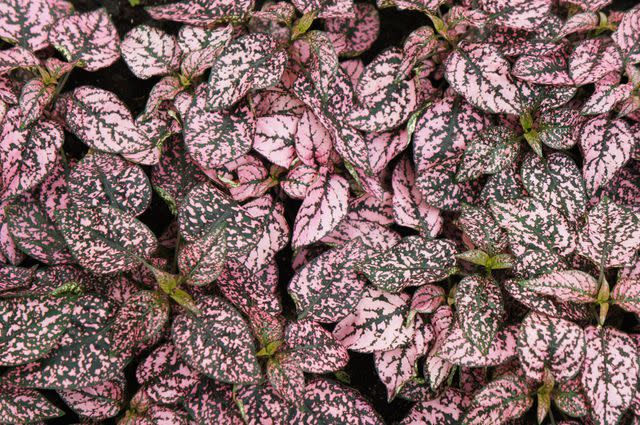
skymoon13 / Getty Images
The cheery pink and green polka dot leaves of the polka dot plant (Hypoestes phyllostachya) are charming additions to shade gardens, both in containers and on the ground. They grow slowly throughout the season and add subtle color to pots with showier plants.
Name: Polka dot plant (Hypoestes phyllostachya)
USDA Hardiness Zones: 10-11
Flower Color: Lilac or pink
Light: Partial shade
Bloom Time: Summer to early fall
Fuschia
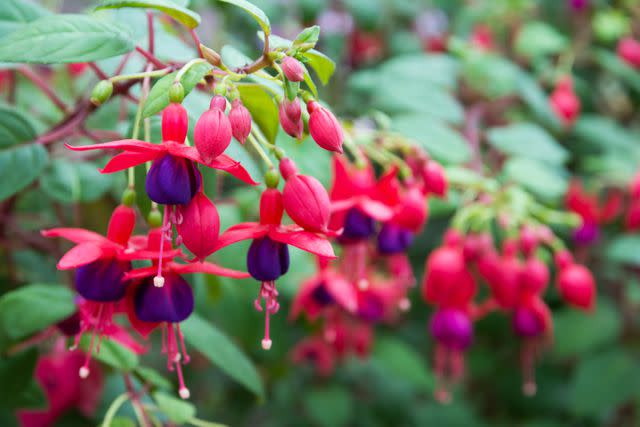
phanasitti / Getty Images
Living up to its name, the vibrantly colored fuschia plant is a favorite of gardeners looking to attract hummingbirds to their yards. These teardrop-shaped flowers cascade beautifully over hanging baskets and thrive in shady, hot spots.
Name: Fuchsia (Fuchsia)
USDA Hardiness Zones: 10-11
Flower Color: Red, pink, white, violet, purple
Light: Partial shade
Bloom Time: Spring through fall
Viola
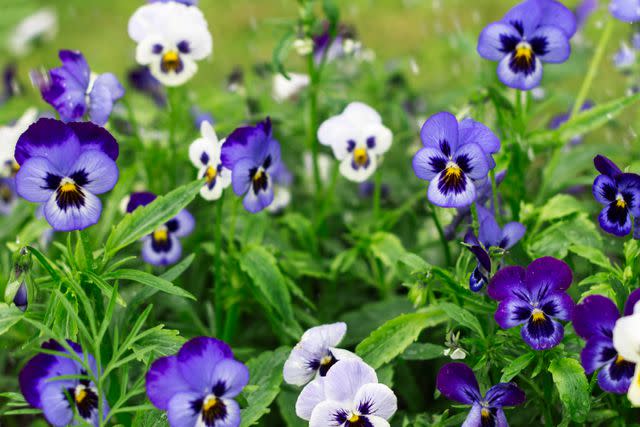
Getty Images/Jurgute
Edible violas are the charming pansy-like flowers you often see on cakes and salads. These small colorful flowers, often seen in purple, orange, or yellow, are right at home in shady, cool temperatures, so they’re at their most vibrant in early spring or fall. Generally, they’ll fade once summer’s heat sets in.
Name: Viola (Viola)
USDA Hardiness Zones: 3-8
Flower Color: Purple, orange, white, blue, yellow, red
Light: Partial shade
Bloom Time: Spring, fall
Wishbone Flower
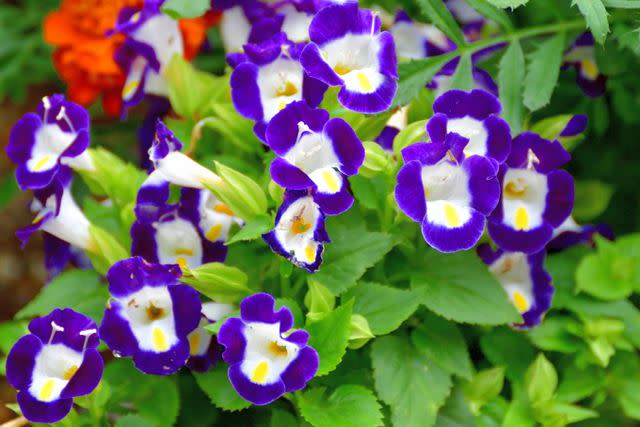
Photos from Japan, Asia and othe of the world / Getty Images
The striking bi-color combinations seen in wishbone flowers (Torenia fournieri) make them a gorgeous addition to any shady garden. Most often, you’ll find these small flowers in shades of purple, and its wishbone-shaped stamen is where it gets its name. Because of their purple-blue color, they’re attractive to pollinators.
Name: Wishbone flower (Torenia fournieri)
USDA Hardiness Zones: 2-11
Flower Color: Pale violet and dark purple, yellow and dark purple, dark purple and white, pink and white
Light: Partial shade
Bloom Time: Spring, summer
Caladium
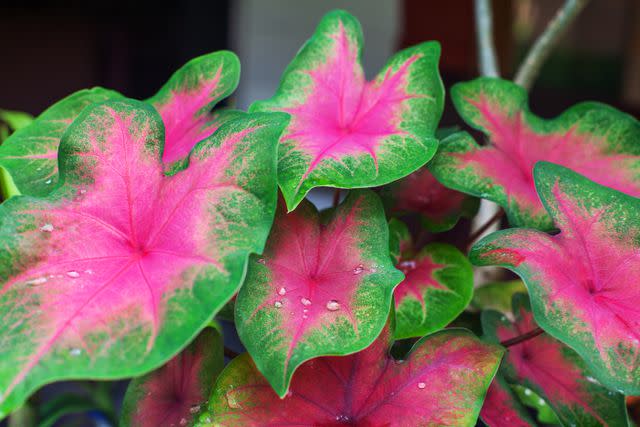
Vera Shestak / Getty Images
Grown as annuals throughout most of the United States, caladiums are heat and shade-loving plants that have striking, arrow-shaped foliage that features shades of neon green, pink, red, and white. The plants do flower, though it’s their leaves that add vibrance and color to shady gardens. This plant is toxic to humans and animals.
Name: Caladium (Caladium)
USDA Hardiness Zones: 9-11
Foliage Color: Green, pink, white, red
Light: Partial to full shade
Bloom Time: Spring, summer, fall
Coleus
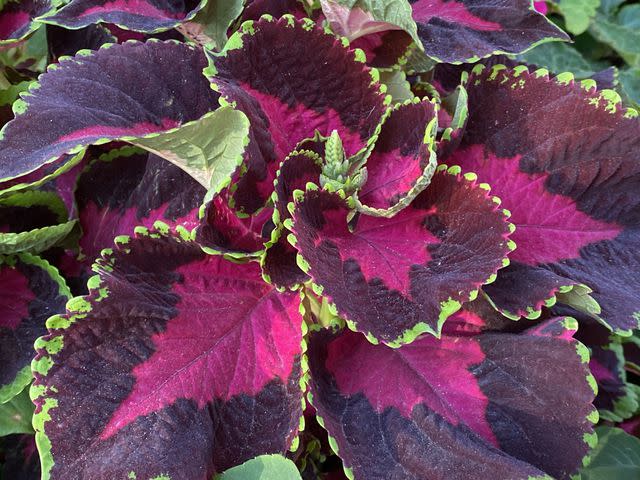
Tiara Maio / Getty Images
Coleus (Plectranthus scutellarioides) features an almost-clashing color palette of chartreuse green and deep maroon on its abundant leaves. When planted in shady areas, Coleus spreads, adding a vibrant ground cover to gardens with its bright color and striking foliage patterns. Coleus is toxic to pets.
Name: Coleus (Plectranthus scutellarioides)
USDA Hardiness Zones: 10-11
Foliage Color: Green, maroon, purple, red
Light: Partial to full shade
Bloom Time: Spring, summer, fall
Cineraria
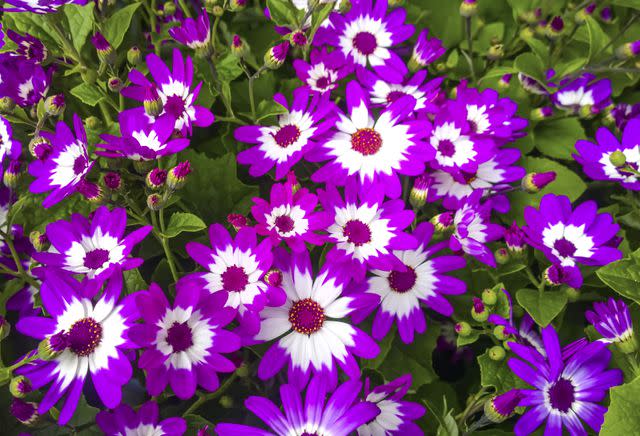
mikroman6 / Getty Images
Cineraria (Pericallis × hybrida) is known for its daisy-like, colorful, and long-lasting blooms that come in a range of delightful colors from purple to pink to lavender, often with a pop of white in the middle. Cineraria prefers cooler weather and blooms four months after seeds are sowed, which can be timed with spring, summer, or fall.
Name: Cineraria (Pericallis × hybrida)
USDA Hardiness Zones: 10-11, grown as an annual everywhere
Flower Color: Purple, pink, red, blue, lavender
Light: Partial to full shade
Bloom Time: Spring, summer, fall
Stock
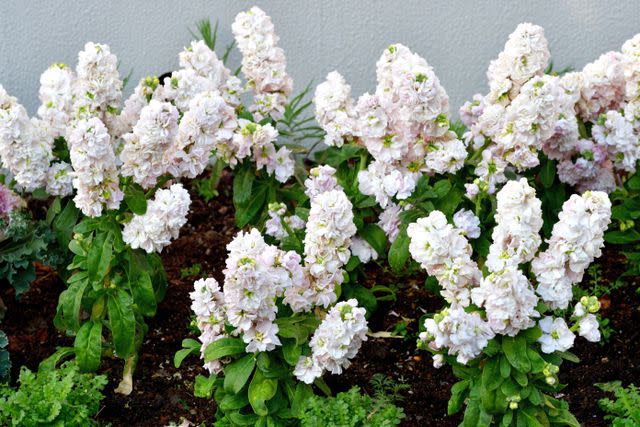
Photos from Japan, Asia and othe of the world / Getty Images
First introduced to the United States by Thomas Jefferson, stock flowers (Matthiola incana) are reminiscent of the tall, bloom-filled stems of some of your favorite spring blooms, like hyacinth. These gently-scented flowers are beautiful in gardens and bouquets alike, and they easily adapt to shaded spaces.
Name: Stock (Matthiola incana)
USDA Hardiness Zones: 7-10
Flower Color: Pink, apricot, purple, blue, white
Light: Full sun to partial shade
Bloom Time: Spring, summer
Impatiens
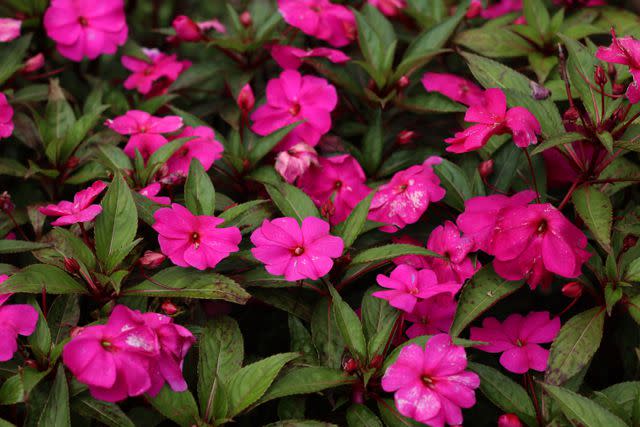
Rizky Panuntun / Getty Images
Impatiens are classic warm-weather flowers with four vibrant petals on billowy blooms. These cheerful flowers have been popular in the United States for decades, where they’re often used in flower beds and containers. In warmer climates, these tropical flowers can be grown as perennials.
Name: Impatiens (Impatiens spp.)
USDA Hardiness Zones: 10-11, grown as an annual everywhere
Flower Color: White, red, pink, orange, purple, yellow
Light: Partial to full shade
Bloom Time: Spring, summer, fall
Nemesia
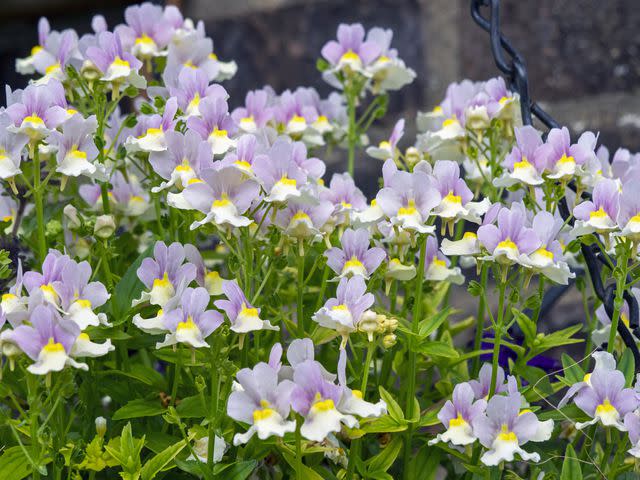
Iuliana Niculaie / 500px / Getty Images
Small nemesia blooms on tall stems covered in pairs of lance-shaped leaves are a joyful addition to spring and summer gardens, filling them with colors of red, orange, purple, pink, blue, and white. Nemesia should be planted before flowering and ahead of its warm weather blooming season. In areas where temperatures remain mild throughout the summer, Nemesia will produce near-constant and abundant blooms.
Name: Nemesia (Nemesia spp.)
USDA Hardiness Zones: 2a-10b, usually grown as annuals
Flower Color: White, red, pink, blue, orange, bicolor
Light: Partial to full shade
Bloom Time: Spring, summer
Snapdragons

aimintang / Getty Images
Snapdragons (Antirrhinum majus) are bright, cool-season flowers that will continue to bloom as long as they receive light afternoon shade and adequate water during the heat of summer. Their tall stems are covered in blooms, which slowly open from bottom to top, attracting bees throughout their bloom season.
Name: Snapdragon (Antirrhinum majus)
USDA Hardiness Zones: 7-11
Flower Color: White, yellow, pink, red, orange, purple
Light: Light shade
Bloom Time: Spring, summer, fall
Beefsteak Plant
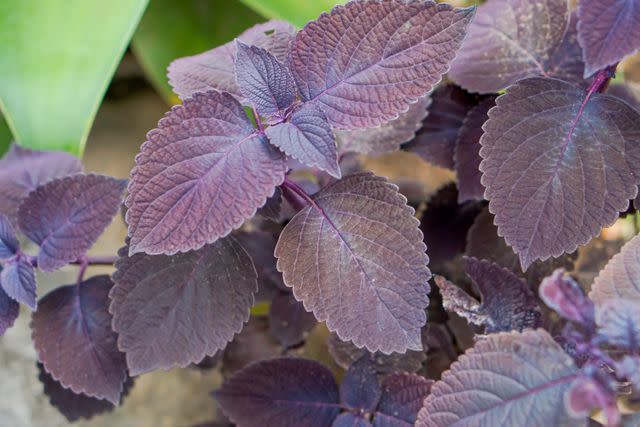
Getty Images/Arvo Vision
Beefsteak plant (Iresine herbstii) is a short-lived perennial typically grown as a tall annual. It has green to dark purple, almost maroon, foliage. While it doesn’t have showy flowers, the plant does provide color and height to shade gardens. It thrives in the heat of summer, allowing its foliage to reach its full vibrant color.
Name: Beefsteak plant (Iresine herbstii)
USDA Hardiness Zones: 10-12
Foliage Color: Green to deep purple
Light: Full sun to partial shade
Bloom Time: Spring, summer, fall
Dichondra
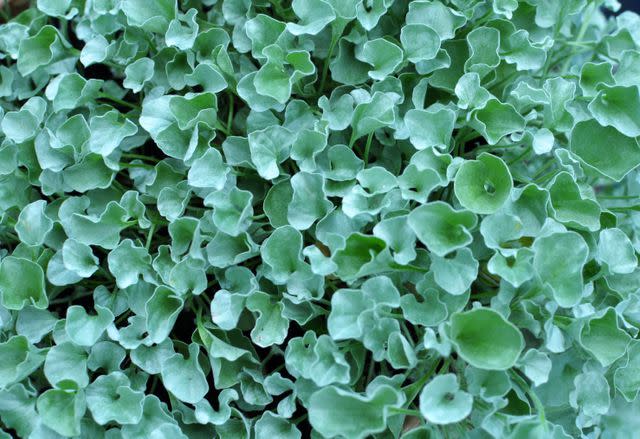
Orest Lyzhechka / Getty Images
Creeping dichondra (Dichondra spp.) is an annual ground cover that has lush, rounded foliage that spreads quickly and trails over the side of container gardens. Its color ranges from vibrant kelly green to silver tinted, and it's a favorite of gardeners looking for a spiller, but it can take over quickly.
Name: Dichondra (Dichondra spp.)
USDA Hardiness Zones: 7-11
Flower Color: White, green, yellow
Light: Full sun to partial shade
Bloom Time: Summer
Sweet Potato Vine
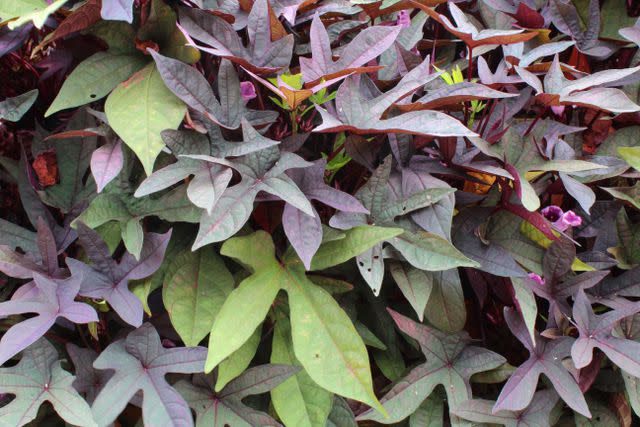
Getty Images/ottoblotto
Unlike its root vegetable counterpart, the sweet potato vine (Ipomoea batatas) is planted for its ornamental look and striking leaves. It quickly grows with leaves that vary in color from neon chartreuse to dark purple to a rich black. The leaves tumble over the sides of containers and gardens, making them a perfect filler plant.
Name: Sweet potato vine (Ipomoea batatas)
USDA Hardiness Zones: 9-11
Foliage Color: Chartreuse, dark purple, black
Light: Full sun to full shade
Bloom Time: Spring to summer
Browalia
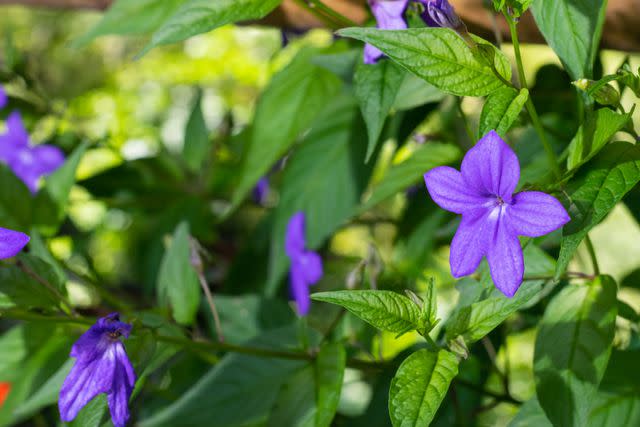
Getty Images/Mauricio Toro
Browallia (Browallia speciosa) is a delightfully low-maintenance flower that is grown as an annual by most gardeners. It produces darling blue, purple, and white blooms on lush green foliage. It grows quickly and spreads, making it perfect for filling in gardens and hanging baskets. Plus, because of its blue color, it attracts hummingbirds and other pollinators. This plant is toxic to cats and dogs.
Name: Browallia (Browallia speciosa)
USDA Hardiness Zones: 10-11
Flower Color: Blue, purple, white
Light: Partial or dappled shade
Bloom Time: Summer, fall
Rose Balsam
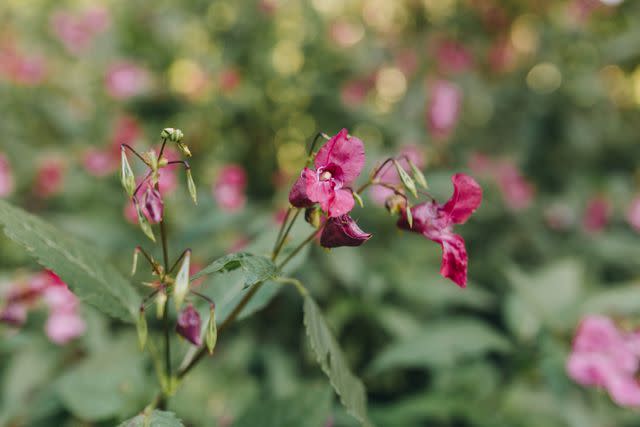
Carolin Voelker / Getty Images
Rose balsam (Impatiens balsamina) has tall stems lined with full, cup-shaped flowers that can reach one to three inches across and provide color and height to shady gardens. The plant’s foliage is relatively sparse, with serrated, long leaves appearing up and down the tall stems, drawing even more attention to its eye-catching blooms.
Name: Rose balsam (Impatiens balsamina)
USDA Hardiness Zones: 2-11
Flower Color: Purple, pink, red, white, bicolors
Light: Partial shade
Bloom Time: Spring, summer, fall
Persian Shield
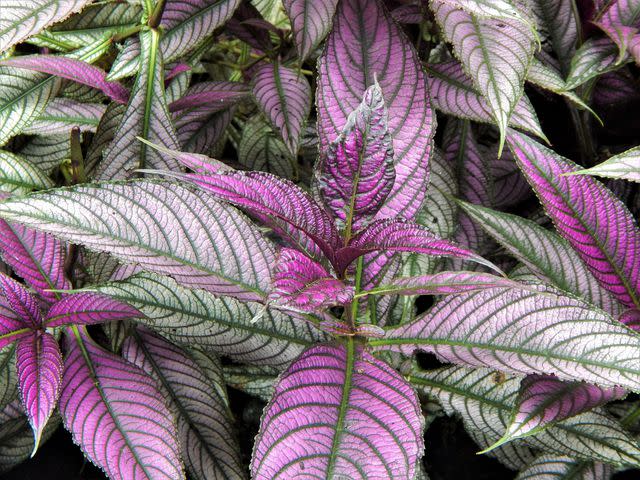
ErikAgar / Getty Images
Persian shield (Strobilanthes dyerianus) is a dramatic annual with leaves that resemble armor shields, with a silver metallic look and striking purple and green contrasting variegation. While it’s often grown as a houseplant that can last year-round and bloom during winter, it also provides color and pattern to warm-weather gardens.
Name: Persian shield (Strobilanthes dyerianus)
USDA Hardiness Zones: 8-11
Foliage Color: Green, purple, metallic, silver
Light: Partial shade
Bloom Time: Fall, winter
Purple Heart
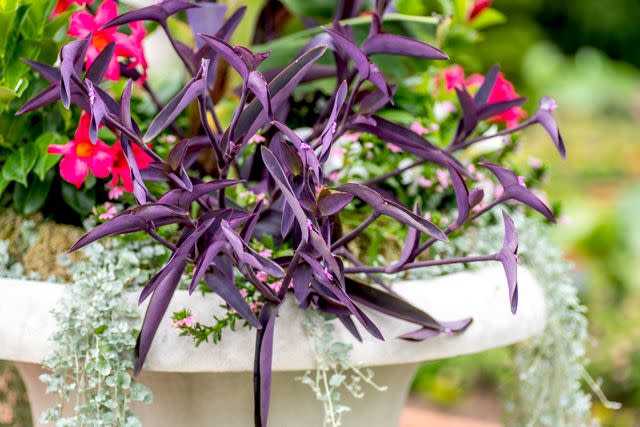
The Spruce / Adrienne Legault
Purple heart (Tradescantia pallida) is a sprawling ground cover that grows in full sun or partial shade. When grown in partial shade, the stems will appear more green than purple though you may enjoy both colors in a spot with dappled sun. You'll also likely see beautiful small flower clusters in violet to pink. In warmer zones, purple heart is grown as a perennial but in cooler climates, it's an annual.
Name: Purple heart (Tradescantia pallida)
USDA Hardiness Zones: 7-10
Flower Color: Purple, pink
Light: Full sun, partial sun, shade
Bloom Time: Spring
Flowering Tobacco
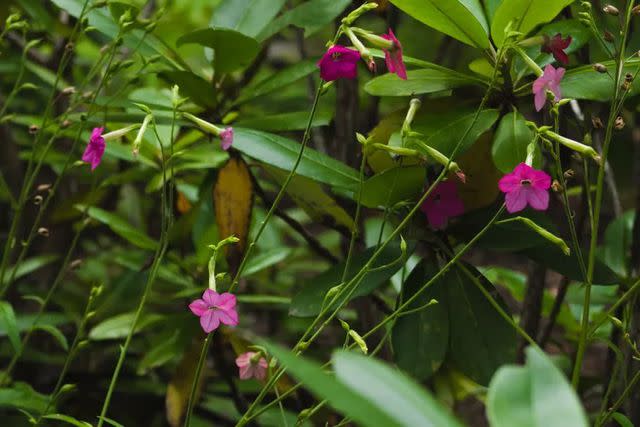
The Spruce / Autumn Wood
Flowering tobacco (Nicotiana alata), along with its cousin, white tobacco (Nicotiana sylvestris), are both short-lived perennials that are often treated as ornamental annuals. They each have long-lasting trumpet-, star-, or bell-shaped blooms and a jasmine-like fragrance that fills the air, even in the shade. The plants prefer at least six hours of sunlight on most days for the best blooms but also appreciate afternoon shade. Be aware it is toxic to humans and pets.
Name: Flowering tobacco (Nicotiana alata)
USDA Hardiness Zones: 10-11
Flower Color: Yellow, green, white, pink, red
Light: Full sun, partial shade
Bloom Time: Spring, summer, fall
Bacopa
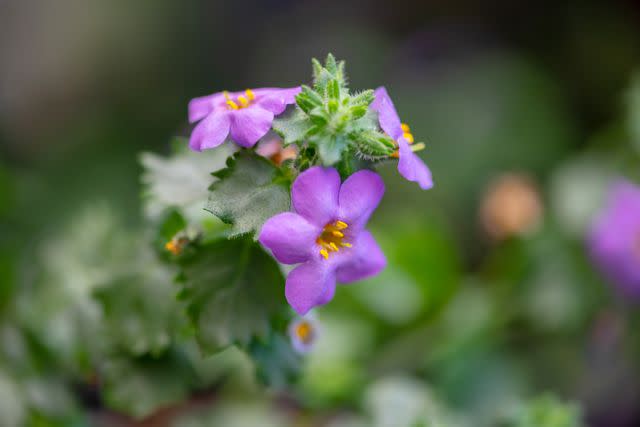
The Spruce / Evgeniya Vlasova
Bacopa (Sutera cordata) is typically grown as a trailing annual ground cover in warmer zones. The plant blooms better with more sun yet won't flower well with too much sun so some shade is preferable. It's worth trying to get the light right for this precious plant that blooms dainty little pastel or white petals surrounding a yellow eye. The best part of this annual is that there's no deadheading required to keep this lush and sprawling flowering ground cover plant going strong.
Name: Bacopa (Sutera cordata)
USDA Hardiness Zones: 9-11
Flower Color: Lavender, pink, red, white
Light: Full sun, light shade
Bloom Time: Summer, early fall
Frequently Asked Questions
Which shade annuals are the easiest to grow?
Classic impatiens are by far the easiest shade annuals to grow. They just need a midsummer pruning to stay bushy and not leggy. If you love impatiens and you also have a sunny area, consider SunPatiens, a hybrid that prefers sunlight but also partial shade.
Which shade annuals bloom all summer?
Begonias and impatiens are shade annuals that will bloom throughout the summer.
Are there any annuals that grow in complete shade?
Many annuals can grow in full shade, such as impatiens, wax begonias, and creeping myrtle. However, it helps to know that full shade for plants does not mean the absence of all sunlight. Other than mushrooms and some mosses, very few plants can thrive in complete shade.
Read Next: 12 Best Annuals for Full Sun
Read the original article on The Spruce.

